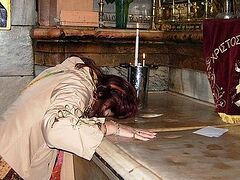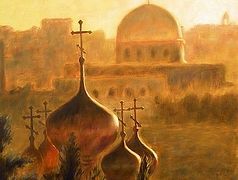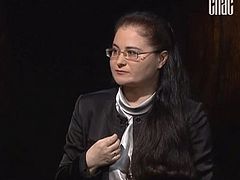One time in Jerusalem, when I was in the city on business, a woman approached me and asked me an unexpected question gingerly, at the same time apologizing:
“Why did you become a nun?”
Smiling, I decided to get out of it with a few words:
“God called me and I was unable to turn down His love!”
To my amazement, the woman liked the answer. But I couldn’t get out of it as she asked me to talk in more detail in a café. I agreed, and she shared her story with me over a cup of coffee. She told me how she came to believe in Jesus Christ.
The woman’s name was Rebecca. Living in the United States, she had a terrible car accident, took a long time to recover and had to have several operations. During that time her husband found another woman. Since they had no children, she was now all alone and decided to move to Israel under the repatriation program. In a new country, starting her life anew, she began to seek solace in religion, attending classes on Judaism regularly.
Rebecca was a diligent student, carefully studying the Old Testament books, Jewish traditions and way of life. One day, while interpreting Isaiah chapter 53, she had her first argument with a rabbi. She kept asking her questions over and again, but he just answered in an agitated tone:
“I’m not going to answer your question because it’s the type of question Christians usually ask!”
This was repeated several times, and the rabbi even began to drop hints, asking whether Rebecca was a Christian.
In such an amazing way, though Rebecca had never been interested in Christianity before, after that remarkable day she began to read the Gospel. And here her inquisitive mind asked a lot of questions again. She looked for all available information on the net since there were no Christians among her acquaintances; so, nearly falling off her feet in her search of answers, one day she cried out to God:
“Lord, let a Jew tell me about Jesus! Only then will I be able to believe in Him!”
A couple of days later, Rebecca came to the Wailing Wall in Jerusalem, and at the women’s section she noticed a woman who was praying fervently and crying bitterly. Rebecca is a kind-hearted person, so she came nearer to the weeping lady and tactfully asked her about the cause of her grief. And she heard the following in reply:
“My dear! I’m not crying for myself, but for poor lost Israel!”
And her words about the Lord Who was crucified and rejected by the people of Israel, about the amazing and fulfilled prophecies, and that salvation can only be gained through faith in Him, poured into Rebecca’s moved heart. The woman she met at the Western Wall turned out to be a Messianic Jewess sent from God, but Rebecca did not get baptized until some time later in a Protestant community. A couple years later, she joined the Anglican Church, concluding that the Protestants she knew had distorted the Savior’s commandment that the faithful participate in the Eucharist (cf. Mt. 26:26-28). It should be noted that as a Protestant, and later as an Anglican, she would attend the Old and New Testament study group several times a week.
It was at that period that my first meeting with Rebecca took place. Her acquaintance with our faith aroused great interest in her, and she immediately noticed that the teaching of the (Orthodox) Church was much deeper than what she had studied so far. But she point-blank rejected the veneration of the Theotokos and icons. Nevertheless, our acquaintance developed into regular communication. One day Rebecca phoned me and asked me straight off:
“Do you pray to Mary, the Mother of Jesus?”
“Certainly.”
A dispute broke out between us. I just had to take a deep breath and wait for the right moment to change the subject. And then a thought appeared in my mind: “Speak now!” But it is hard to carry on such a difficult dialogue over the phone when you can’t see the person you are talking with. In addition, there were also difficulties with the language because I can’t speak English perfectly. What should I say? I decided to have a try…
“Rebecca, was the Ark of the Covenant a great shrine in the Old Testament, or was only what was inside it considered holy?”
“Yes, of course, both the Ark of the Covenant and its contents were holy,” she replied.
“How can it be? Can a simple box—well, of course, a gilded one—be holy? After all, this is real idolatry!” I continued my maneuver.
Rebecca fell silent in perplexity.
“Listen,” I went on. “The container in the Old Testament was sanctified by what was inside it! Likewise, by bearing the Infant Christ in Her womb for nine months the Most Pure Virgin was sanctified by His presence. After all, an unworthy woman couldn’t have given birth to God!”
And suddenly after these words I heard some incomprehensible sounds in the receiver—at first sobbing, and then the woman just burst into tears. I got scared. But next in the midst of these sobs I heard:
“Thank you, mother! Thank you for saying this! I’ll pray to the Theotokos straight away. I’ll pray to Her on my knees!”
At that point our conversation was interrupted.
After a while, Rebecca wanted to visit Gorny Convent as she was attracted by the monastic life. Then I had to fulfil her longtime dream and show her my cell. Seeing the many icons inside, Rebecca stood in the middle of the room and looked in surprise at me, then at the icons alternately.
“Mother Mariam,” she said confusedly. “Do you pray in front of the icons? And do you kiss them?”
“Surely I do! This cell is my little Paradise, and the icons are part and parcel of it!”
After these words, Rebecca came up nearer the icon corner and started scrutinizing the icons. All of a sudden she saw a very small icon, took it into her hands and asked:
“Who is this?”
“It’s St. Simeon the God-Receiver. As you see, he is holding the Infant Christ in his arms.”
I was already beginning to explain to her the symbolism of the icon, the special language of color, gestures and objects depicted… But it turned out that she didn’t need my explanations. Rebecca was standing, pressing the icon to her heart, kissing it, and her face was shining like she had just found a priceless treasure.
“Please, mother,” I suddenly heard. “Give me this icon. I’ll pay you whatever the cost and you can buy another one. I can’t leave this place without it!”
I had to give her the icon, though it was also very dear to me—a gift from one fellow nun.
It was a great miracle of Elder Simeon. From that time on Rebecca began to venerate icons and carried the icon of Elder Simeon throughout Jerusalem, showing it in her circles. Through communication with Rebecca many people, including Messianic Jews, began to see the reflection of the Gospel mystery in icons.
P.S. I would like to add that perhaps the best icon of the holy Elder Simeon that I have ever seen is kept at the Greek Orthodox Monastery of St. Simeon the God-Receiver in the Katamon neighborhood of Jerusalem. It is a replica of the miracle-working icon that appeared in the fifteenth century in Veliky Novgorod and is kept at the Holy Protection Zverin Convent [one of the earliest convents in Russian history, which existed from the eleventh or twelfth century until 1919.—Trans.]At the bottom of the icon there is an inscription which reads: “An exact copy of the ‘Measure and Likeness’ icon which appeared in Novgorod.” The replica of that wonder-working icon was presented to the monastery of Katamon by pilgrims from Russia, perhaps even from Zverin Monastery in Veliky Novgorod. The original miracle-working icon of Righteous Simeon the God-Receiver, holding the Baby Christ in his arms, was famous for saving people of the lands of Novgorod and Pskov from a terrible plague in 1467. The akathist hymn to St. Simeon the God-Receiver for that icon was composed by the future Abbess Taisia (Solopova; 1842–1915) of the St. John the Baptist Leushinsky Convent during her stay at Zverin Convent. However, the celebrated icon was lost in the 1920s during anti-Church persecutions.




